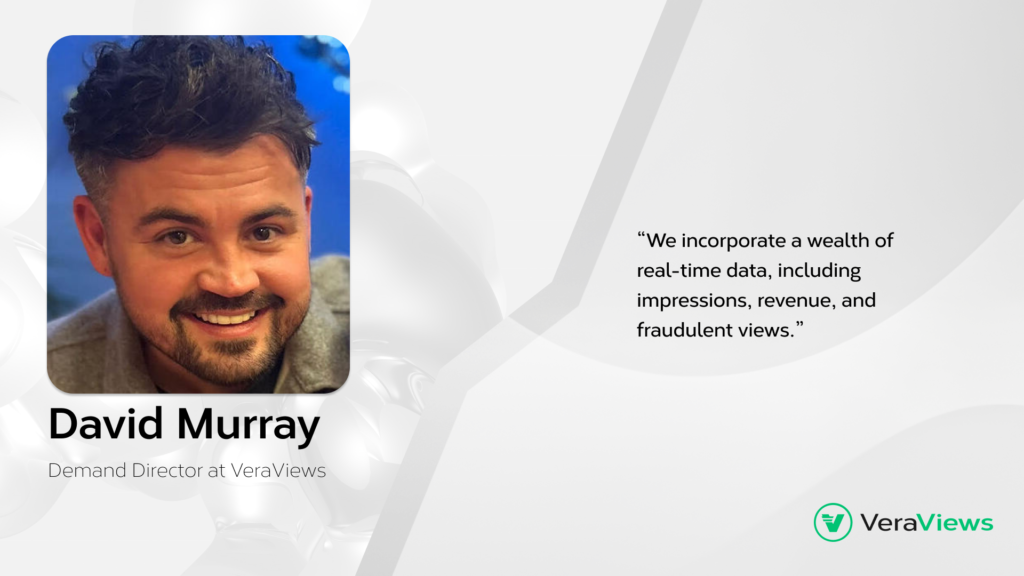New Digital Age meets David Murray, Demand Director of VeraViews to discuss ad fraud in video advertising and increasing trust and value across the media ecosystem…
Congratulations on your new role. So, what does it entail?
Thank you, and it’s very exciting to be part of this growing VeraViews team.
I’m focusing on building our partnerships with SSPs, DSPs and networks and helping them plug their in-stream video campaigns into our publisher partners’ video supply. It’s a brand-new role, so I’m sure it will evolve as the business grows.
You’ve come from a publisher background. What attracted you to move to a technology business?
Yes, my experience has very much been on the supply side. Over the past few years, my passion has been for in-stream video and developing this revenue stream opportunity for publishers. In doing so, I became exposed to the reporting discrepancies, invalid traffic and poor campaign performance issues that challenge this media.
Tackling these was a daily battle of trying to understand what was happening, why it was happening and what action could be taken to address them. And the discrepancy issues arising from fraud naturally play on the sensitivities of demand partners: when there is a failure to perform, publishers are switched off, and future revenues are lost.
These experiences have given me the desire to address advertising’s woes and help clean up the industry. VeraViews’ mission aligned with my interests and where I wanted to go professionally, so the opportunity was perfect for me. And here I am.
As a business, VeraViews is focusing on tackling ad fraud. It’s a huge issue, but why is the industry slow to address it?
I’d say it’s the industry’s biggest threat. There are several initiatives attempting to work towards a solution, so that’s a positive. But the critical element lacking from any approach is legislation, backed up by enforcement so that fraudsters can be brought to justice. As a result, it all feels very slow.
What’s clear is collaboration is essential. This isn’t just an issue impacting some elements of the industry. It’s affecting all parts, including consumers. That’s why the industry must unite. We need to start bringing together the knowledge and data that exists across the supply chain and use this to achieve the shared goal of eliminating ad fraud.
And the data is out there. While sometimes there are genuine technical challenges in accessing it, or companies don’t want to expose their proprietary methodologies, it’s often down to an unwillingness to share it. But we need to overcome this reluctance.
Yes, it is difficult for companies, as doing what’s right to clean up the industry can have commercial implications. But in the long term, everyone will benefit.
And if we think it’s too hard for the industry to tackle this, it’s much preferable than the alternative – government-imposed legislation without industry consultation.
Why’s transparency so hard to deliver?
It’s because despite all the talk in public, when it comes down to it, many tech offerings remain black boxes, making it very difficult to share that data. Lip service around transparency needs to be replaced by action.
Certain businesses also have little incentive to tackle fraud because they’re indirectly benefiting from the status quo. While it mightn’t be done maliciously, the urgency to eradicate it may be lacking if you’re making money from it.
There’s also been a lack of technology available to deliver an open, transparent record of ad campaign data. But this is changing.
An approach VeraViews offers is through distributed ledger technology. What is this?
We prefer to call it an open ledger as this conveys the transparent nature of it.
It’s a single, immutable database that records every ad engagement between an advertiser, publisher and all the intermediaries involved in delivering a campaign. Additionally, we incorporate a wealth of real-time data, including impressions, revenue, and fraudulent views.
The result is a single, open, and transparent source of campaign truth that’s impossible to manipulate and can be accessed by all parties. This provides insights into both campaign reporting and invalid traffic (IVT) tracking.
With the technology storing blacklisted IP addresses and invalid and fraudulent views, all parties can use these insights to take direct action to tackle fraud going forward, while the platform can also prevent IVT.
And having this one undisputable source of campaign insight also speeds up the payment process for publishers. It irradicates the traditional discrepancy issues between publishers and advertisers, which often have the most negative impact on publisher revenues.
Looking forward to the rest of the year, how do you see 2023?
I’ve got a positive feeling that this is the year of industry collaboration. 2023 will see the industry come together and seriously start tackling ad fraud. There are so many reasons for doing it from an ethical, industry, social and political perspective that we must make it happen.
Personally, I’m also looking forward to helping VeraViews with its ongoing evolution this year. There’s so much potential here, and with a small but very experienced team assembled, it’ll be exciting to see where it goes and be part of the journey.









